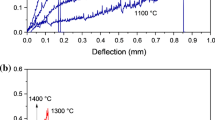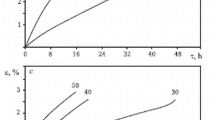Abstract
The effect of bending stress s of different magnitudes and signs on the fracture toughness K 1c of polycrystalline specimens of partially stabilized zirconia (PSZ) is considered. A method for testing pre-stressed PSZ specimens by Vickers indentation using a four-point bending scheme is proposed. The dimensions of the impression from a diamond pyramid and the length of the radial cracks generated thereby are determined. An anisotropy of strength properties is revealed in the specimens tested, which is explained by the involvement of two mechanisms: forcing action of an external stress on the crack opening and activation of the tetragonal- monoclinic phase transition in the tensile stress field.
Similar content being viewed by others
REFERENCES
E. Masaharo and S. Somia, “Microstructural development of zirconia-toughened ceramics,” Seramikkusu, 21(2), 126–134 (1986).
D. S. Rutman, Yu. S. Toropov, S. Yu. Pliner, et al., Zirconia-Based Refractory Materials [in Russian], Moscow, Metallurgiya (1985).
A. H. Heuer, “Transformation toughening in ZrO2-containing ceramics,” J. Am. Ceram. Soc., 70(10), 689–698 (1987).
G. S. A. M. Theunissen, I. S. Bouma, A. J. A. Winnubst, and A. J. Buggraaf, “Mechanical properties of ultra-fine grained zirconia ceramics,” J. Mater. Sci., 27, 4429–4438 (1992).
G. A. Gogotsi, V. I. Galenko, B. I. Ozerskii, et al., “Resistance to fracture, strength and other characteristics of Y2O3-stabilized zirconia ceramics,” Ogneup. Tekh. Keram., No. 8, 7–13 (2000).
D. V. Marshall and A. G. Evans, “Reply to comment on elastic-plastic indentation damage in ceramics: the median-radial crack system,” J. Am. Ceram. Soc., 64(12), 182–183 (1981).
J. W. Adams, R. Ruh, and K. S. Mazdiashi, “Young's modulus, flexure, and fracture of yttria-stabilized zirconia versus temperature,” J. Am. Ceram. Soc., 80(4), 903–908 (1997).
G. A. Gogotsi and E. E. Lomonova, “A Raman microprobe study of phase transformations in zirconia crystals tested by Vickers indentation,” Ogneup. Tekh. Keram., No. 6, 4–9 (2000).
V. I. Barbashov and G. Ya. Akimov, “Specific feature in the fracture of hydrostatically compressed zirconia,” Fiz. Tverd. Tela, 38(6), 1820–1822 (1996).
T. K. Gupta, F. F. Lange, and J. H. Bechtold, “Effect of stress-induced phase transformation on the properties of polycrystalline zirconia containing a metastable tetragonal phase,” J. Mater. Sci., 13, 1464–1470 (1978).
F. F. Lange, “Transformation toughening. Part 2. Contribution to fracture toughness,” J. Mater. Sci., 17, 235–239 (1982).
V. I. Barbashov, G. A. Gogotsi, G. Ya. Akimov, V. I. Timchenko, and É. V. Chaika, “A specific feature in the fracture of polycrystalline zirconia ceramics,” Ogneup. Tekh. Keram., No. 2, 5–8 (2002).
Author information
Authors and Affiliations
Rights and permissions
About this article
Cite this article
Barbashov, V.I., Tkachenko, Y.B. Anisotropy of Mechanical Properties of Zirconia-Based Ceramics Tested for Bending. Refractories and Industrial Ceramics 45, 52–54 (2004). https://doi.org/10.1023/B:REFR.0000023352.59346.1f
Issue Date:
DOI: https://doi.org/10.1023/B:REFR.0000023352.59346.1f




